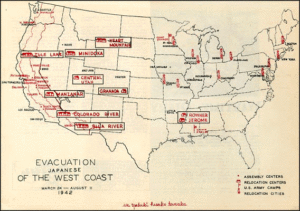The creation of Japanese internment camps represents an under examined aspect of American participation in World War II. On 19 February 1942, President Franklin D. Roosevelt issued Executive Order 9066. Ostensibly driven by security concerns, 9066 authorized the relocation and internment of Japanese Americans. Using confidential US Census Bureau information, the US government identified and forcibly moved 120,000 Japanese Americans to internment camps. The standard for determining whom to move was as little as 1/16th Japanese ancestry. That requires only one of your great-great-grandparents to be Japanese, or one full blood direct line relative in the last century.
Regional military commanders executed the incarceration orders based on the security of military areas. The vast majority of the internees were moved from areas along the west coast to camps in the interior of the country. Over 60 percent of the internees were US citizens. Oddly enough in Hawaii, where over a third of the nearly half-million residents met the criteria, fewer than 2,000 were incarcerated.
Fred Korematsu, a naturally born American of Japanese ancestry, defied the order. His case made it all the way to the US Supreme court. In a 6-3 decision the Court sided with the government on a very narrow interpretation of the issues. Basically, they ruled that excluding citizens from an area for security reasons was constitutional. They explicitly avoided the constitutionality of forcibly removing and interning citizens.
Efforts to Correct the Injustice
The vote was clearly politically motivated – eight of the court’s members were FDR appointees. Additionally, the government failed to provide intelligence information stating there was no evidence of spying within the Japanese American community. The withholding of evidence led to courts voiding Korematsu’s conviction in 1983. While the original Supreme Court decision remains, in 2011 the Department of Justice filed official notice of that the government’s defense of the policy had been in error.
As for redress, in 1980 President Jimmy Carter appointed the Commission on Wartime Relocation and Internment of Civilians (CWRIC) to investigate. Their report concluded that racism rather than espionage drove incarceration. In 1988 President Ronald Reagan signed a law officially acknowledging and apologizing for the racial prejudice. The law also authorized the disbursement of $20,000 to each internee.
Map detailing the Japanese evacuation of the west coast during World War II (courtesy of the Japanese American National Museum).
As an aside please consider signing up for my FREE author newsletter. It will contain opportunities to preview new books, announcements, and contests related to my novels. It will not overwhelm your inbox – I’m thinking once a month or less depending on news.
If you have subscribed, but haven’t received a newsletter, please check your spam folder. Moving the newsletter to your inbox should fix the issue.
As always thanks for reading.
Armen
Note to pay the bills
Does a James Bond-like thriller set in a high fantasy world of magic, monsters, and mythical beasts interest you? Then checkout The Warders. You can find a summary of the series here or find links to purchase books here.



How sad. How very, very sad.
…and we’re still making decisions like this today (ie: immigrants).
Will we ever learn?
Rick, regardless of your views about the current immigration situation, this was even worse – many of these people were US citizens.